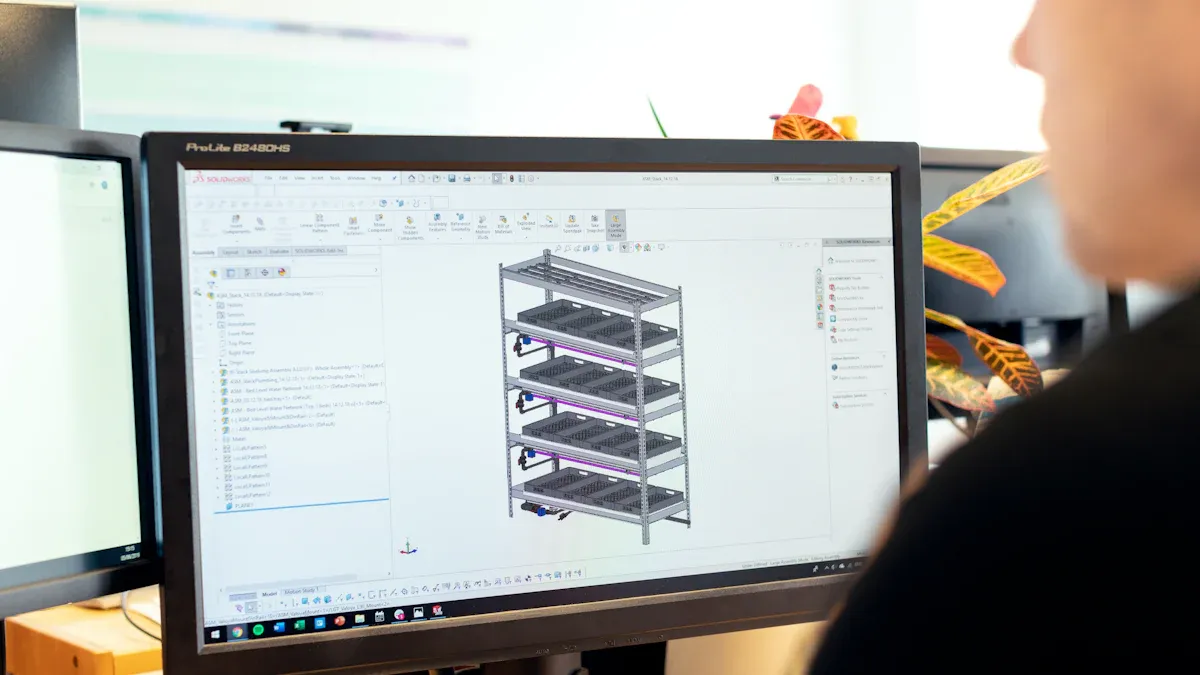Understanding the DS1307 Real-Time Clock and Its Modern Applications

The DS1307 RTC module is a dependable clock for keeping time. It keeps track of seconds, minutes, and hours very accurately. A battery backup helps it keep working even if power goes out. The DS1307ZN+T&R fits easily into small electronic systems. It works well for tasks needing exact timing. This clock can show time in 12-hour or 24-hour formats. It is very useful for things like automation, saving data, and digital clocks.
Key Takeaways
The DS1307 RTC module keeps time well, tracking seconds, minutes, and hours. It works even during power outages because of its battery backup.
Its I2C interface makes it easy to connect to microcontrollers. This makes it great for projects like digital clocks and data recorders.
The module has 56 bytes of non-volatile SRAM. This memory keeps important data safe even when the power is off.
The DS1307 works well in smart home devices and robots. It helps automate tasks and keeps timing accurate for better performance.
Its small size and low power use make it great for portable devices. It works well in things like watches and handheld gadgets.
Key Features of the DS1307 RTC Module

The DS1307 RTC module is packed with useful features. It is a dependable choice for keeping time in many projects. Its design makes it easy to fit into small systems while staying accurate and efficient.
Real-Time Clock Functionality
The DS1307 is great at keeping real-time clock data. It tracks seconds, minutes, hours, days, dates, months, and years. It even adjusts for leap years until 2100. This helps it stay accurate for a long time. You can choose between 12-hour or 24-hour time formats. Here’s a table comparing its drift rate:
RTC Module | Drift Rate |
|---|---|
DS1307 | 7-10 seconds per day |
DS3231 | About 2 seconds per month |
This accuracy makes it perfect for tasks like digital clocks or saving data.
Battery Backup for Uninterrupted Timekeeping
The DS1307 has a battery backup to keep time during power outages. This is important for systems that need to keep time even without power. Devices like the SP3485EN-L/TR use this feature for steady performance. The battery backup also saves energy, making it great for portable gadgets.
I2C Interface for Easy Integration
The DS1307 uses an I2C interface with just three wires: SCL, SDA, and GND. This makes it simple to connect to different projects. It works well with microcontrollers like the MCP2515-I/ST or computers like Raspberry Pi. The code can be used on different devices, making it easy to switch systems. It also works with devices like the FT230XS-R and 24FC1025-I/S, showing how flexible it is.
The DS1307's I2C interface makes it easy to use, which is why developers like it for timing projects.
Non-Volatile SRAM for Data Storage
The DS1307 clock has 56 bytes of non-volatile SRAM. This memory keeps data safe even when power is off. Engineers use it to save important settings or temporary data. This helps systems work smoothly after power comes back.
The SRAM works well with the DS1307's I²C interface. It allows easy data sharing with devices like microcontrollers. Developers can quickly save and read data using simple commands. The DS1307 guide explains how the SRAM works and its I²C compatibility.
A big benefit of this SRAM is its reliability. Unlike regular memory, it keeps data when power is lost. This is great for systems like data loggers or embedded devices. For example, a weather station can store readings without losing them during outages.
The SRAM's small size fits projects needing little memory. While 56 bytes isn’t much, it’s enough for many tasks. It can store timestamps, sensor data, or user settings. This makes the DS1307 useful in modern electronics.
The DS1307's SRAM is reliable for saving key data. It helps systems stay efficient, even during power failures.
Parts of the DS1307ZN+T&R
DS1307 IC: The Main Part
The DS1307ZN+T&R module uses the DS1307 chip to keep time. This chip tracks seconds, minutes, hours, days, months, and years. It even adjusts for leap years until 2100. It connects to microcontrollers using a simple two-wire I2C system. The chip runs on 5V power and comes with the current time set. This makes it easy for developers to start using it.
The DS1307 chip also detects power failures and switches power automatically. This keeps it running smoothly during power changes. Its small size, in an 8-pin SOIC/DIP package, fits well in small systems. It also has a 1Hz pin to create clock signals, making it useful for timing tasks.
Feature/Spec | Details |
|---|---|
Voltage | 5V |
Package | 8-pin SOIC/DIP |
Interface | Two-wire I2C |
Output Pin | 1Hz output |
Power Use | < 500nA in backup mode |
Memory | 56 Bytes |
Pre-set Time | Yes |
Leap Year | Valid until 2100 |
32kHz Crystal Oscillator for Accuracy
The DS1307 module has a 32kHz crystal oscillator for precise timekeeping. This part gives a steady frequency, keeping time accurate for long periods. It reduces errors, making it great for clocks and data storage systems.
The oscillator works with the DS1307 chip to ensure reliable timing. It keeps the module working well, even if power conditions change. Developers often use it with microcontrollers for synced operations in small systems.
Battery Backup for Power Loss
The DS1307 module has a battery backup to keep time during power cuts. This lets the chip run on battery power and keep time accurate. The battery uses very little energy, about 2 µA, in backup mode. This makes it perfect for low-power devices.
The battery backup removes the need to reset time after power loss. It helps the module start working again without delays. Devices like Arduino can use this feature to wake up from sleep mode. This shows how well the module saves energy.
The DS1307's battery backup keeps time running, making it dependable for portable systems.
SRAM for Saving Time Data
The DS1307 RTC module has 56 bytes of SRAM. This memory keeps data safe even when power is off. Engineers use it to save important settings or temporary data during power loss.
The SRAM works well with the DS1307 chip for storing data. Developers can easily save and read data using simple I²C commands. This makes it work with devices like Arduino and Raspberry Pi. For example, a weather system can save timestamps and sensor readings in the SRAM, keeping data safe during outages.
The SRAM is small but useful for many tasks. While 56 bytes isn’t much, it’s enough for storing settings, user preferences, or sensor data. This makes the DS1307 great for devices like data loggers, smart meters, and portable gadgets.
A big benefit of the SRAM is its reliability. Unlike other memory, it keeps data even when power is off. This helps systems work smoothly in important tasks. For example, machines can use it to save error logs or schedules during shutdowns.
The DS1307's SRAM is dependable for saving time data. Its I²C connection makes it easy to use in modern devices.
How the DS1307 Real-Time Clock Works
Timekeeping Mechanism
The DS1307 clock keeps time using Binary-Coded Decimal (BCD). This method helps it track seconds, minutes, hours, days, and years. It adjusts for leap years and month-end dates automatically. You can pick 12-hour or 24-hour time formats based on your needs.
A 32kHz crystal oscillator helps the clock stay accurate. The crystal's quality and setup affect how precise it is.
The DS1307's accuracy depends on the crystal's stability. Adjusting it with a trimmer capacitor can improve precision.
This reliable timekeeping system makes the DS1307 great for tasks needing steady time tracking.
Communication via I2C Protocol
The DS1307 uses I2C to talk to other devices. This two-wire system has SCL (clock) and SDA (data) lines. It makes connections simple and reduces the number of pins needed. The I2C system lets the clock share data easily with microcontrollers.
The module also has 56 bytes of non-volatile SRAM. This memory saves important data even when power is off. Together, I2C and SRAM make the DS1307 useful for many projects.
Synchronization with Microcontrollers
The DS1307 works well with different microcontrollers for accurate timing. Developers often pair it with microcontrollers like the PIC16F877A or Atmega328p. These setups help the clock provide exact time for tasks like logging data or scheduling.
A digital clock project shows how the DS1307 works with the PIC16F877A.
Another example shows it syncing with the PIC16F887A during software use.
A smartwatch project highlights its use with Arduino-based systems like Atmega328p.
This ability to work with many microcontrollers makes the DS1307 a good choice for simple and advanced devices.
Role of the Battery in Keeping Time
The battery helps the DS1307 clock work during power cuts. It keeps time accurate when the main power is off. The DS1307 switches to battery power automatically if power fails.
This module often uses a CR2032 coin battery. This battery can last over 10 years at 25°C. One user said their DS1307 stayed accurate for three years with the same battery. These examples show how reliable the battery is for keeping time.
Some things affect how long the battery lasts. Batteries lose 1-2% power each year naturally. Hot or wet conditions can damage the battery or circuit board. Storing and using the battery properly helps it last longer.
The DS1307 uses very little power in backup mode. It needs less than 500nA, which saves battery life. This makes it great for portable devices needing low energy. The battery keeps time during outages, so the system works without resetting.
The DS1307's battery backup is reliable and easy to use. It’s a great choice for modern electronics.
Applications of the DS1307 RTC Module

Digital Clocks and Watches
The DS1307 RTC module is important for digital clocks and watches. It keeps track of time accurately, including leap years. You can choose between 12-hour or 24-hour formats for different clock styles. Its battery backup keeps it running during power outages. This is very helpful for portable devices like wristwatches.
The DS1307 chip is small and uses little power, making it great for wearables. People use it in DIY projects to make custom clocks. For example, hobbyists can add alarms or timers using its 1Hz output pin. Its accuracy and easy setup make it popular for personal and commercial clocks.
Data Logging Systems
The DS1307 RTC module is useful in systems that log data. It timestamps data to track events over time. Weather stations use it to record temperature, humidity, and other readings.
Its non-volatile SRAM saves data even when power is off. This keeps important information safe until power returns. Developers pair it with microcontrollers for efficient logging systems. For example, solar-powered farm devices use it to manage feeding schedules based on real-time data.
Smart Home and IoT Devices
The DS1307 RTC module improves smart home and IoT devices. It helps automate tasks like turning on lights or appliances. Its I2C interface makes it easy to connect with microcontrollers, so developers like using it for IoT projects.
Smart thermostats and energy meters use the DS1307 to work better with time-based data. Its battery backup keeps it running during power cuts, so schedules stay accurate. DIY enthusiasts also use it to build custom smart home systems for their needs.
Robotics and Automation
The DS1307 RTC module is important for robots and automation. It helps robots keep time and stay in sync. Robots need this module to work with sensors and move correctly. Drones use it to follow flight paths and collect data on time.
Robots in factories also use the DS1307 for tasks like motor control. It helps them collect sensor data and stay accurate. If power goes out, the module keeps working with its battery backup. This is helpful in places where power often fails.
The DS1307's I2C interface makes it easy to connect to microcontrollers. Developers use it for many robotic projects, from simple to advanced. Its low power use and battery backup are great for portable robots and devices.
The DS1307 helps robots work better by keeping time steady. It makes sure robots run smoothly in all kinds of tasks.
Medical and Industrial Equipment
The DS1307 RTC module is useful in medical and factory tools. It keeps time for devices that need exact schedules and logs. Medical tools like infusion pumps use it to track important tasks. It helps these devices work without mistakes.
In factories, the DS1307 helps machines log errors and events. Engineers use this data to fix problems quickly. Its memory saves data even if power goes out, so nothing is lost.
The module's battery backup is very helpful in medical and factory settings. It keeps time during power cuts, so devices keep working. Tools like smart meters and factory machines depend on this feature.
The DS1307 is accurate and reliable for medical and factory tools. It helps these systems work without stopping or losing data.
The DS1307 RTC module helps keep time accurately in devices. It has useful features like I2C connection, battery backup, and memory. These make it a trusted part for small systems. It keeps the correct time even when power goes out. The module works well in many things, like clocks and factory machines. By tracking time steadily, the DS1307 is important for systems needing reliable timekeeping.
What does the DS1307 RTC module do?
The DS1307 RTC module helps devices keep track of time. It records time and date, even if the power goes out. A battery backup ensures it keeps working. It is used in digital clocks, data loggers, and smart home gadgets.
How does the DS1307 work during power outages?
The DS1307 has a battery backup to keep running. When the main power stops, it switches to the battery. It uses very little energy to stay accurate.
Tip: Use a CR2032 coin battery for long-lasting use.
Can the DS1307 work with any microcontroller?
Yes, the DS1307 works with most microcontrollers using its I2C connection. It connects easily to Arduino, Raspberry Pi, and PIC microcontrollers. Its two-wire system makes setup simple.
How precise is the DS1307 RTC module?
The DS1307 can drift by 7–10 seconds daily. Its accuracy depends on the 32kHz crystal oscillator. You can improve precision by adjusting the crystal with a trimmer capacitor.
Why is the DS1307 good for portable devices?
The DS1307 uses very little power, especially in backup mode. Its small size, battery backup, and low energy use make it great for portable tools like watches and handheld devices.
Note: The DS1307 uses less than 500nA in backup mode, saving energy.
See Also
Understanding MC9S12DJ256MFUE Specs For Car Technology
Key Programming Techniques For MC9S12XD256 Microcontrollers
Enhancing Automotive Efficiency With MC9S12XEP100 And NXP
CALL US DIRECTLY
(+86)755-82724686
RM2508,BlockA,JiaheHuaqiangBuilding,ShenNanMiddleRd,Futian District,Shenzhen,518031,CN
www.keepboomingtech.com sales@keepboomingtech.com
